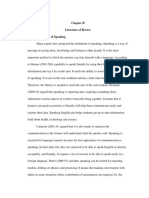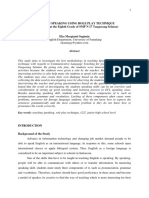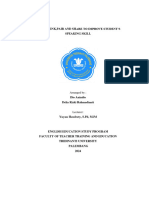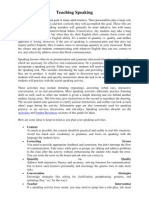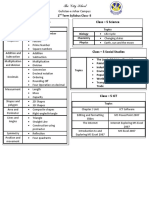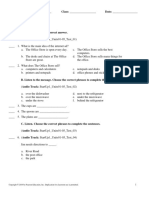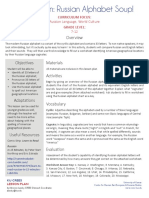Speaking TBL 2 Indonesian
Speaking TBL 2 Indonesian
Uploaded by
Eko Wahyu ApriliantoCopyright:
Available Formats
Speaking TBL 2 Indonesian
Speaking TBL 2 Indonesian
Uploaded by
Eko Wahyu ApriliantoOriginal Description:
Copyright
Available Formats
Share this document
Did you find this document useful?
Is this content inappropriate?
Copyright:
Available Formats
Speaking TBL 2 Indonesian
Speaking TBL 2 Indonesian
Uploaded by
Eko Wahyu ApriliantoCopyright:
Available Formats
The Effectiveness of
Speaking Instruction through
Task-Based Language Teaching
Noor Malihah
English Department of Education Faculty
State Islamic Studies Institute (STAIN) of Salatiga
Jl. Tentara Pelajar No. 02 Salatiga 50721 Indonesia
noormalihah_itah@yahoo.com
Abstract
Speaking is a crucial part of second language learning and teaching.
Teaching speaking is not merely to let students to repeat or memorize
dialogues, but they should be able to use the utterance to communicate in
the real situations. Teachers attitudes to respond the students thought
and opinion is important, as they should not be forced to speak and put
them in the deep anxiety, but we invite the learners to use any languages
in the performance of oral tasks where teachers give a task and learners
complete the task. Teachers should be able to create such situations where
students hold meaningful tasks that will promote their speaking
proficiency. This can be realized when students works with their friends
in groups to complete a task. Task-Based approach is the alternate to
solve the problem where learning is developed through performing a series
of activities as steps towards successful task realization.
Key words: Language learning and teaching, speaking instruction, taskbased approach, task
REGISTER, Vol. 3, No. 1, June 2010
85
The effectiveness of speaking instruction through task-based language teaching
Introduction
Developing interactive teaching strategy is very essential in creating
meaningful communication. The traditional approaches of language
teaching (Grammar Translation, Direct Method, and Audiolingual
Method) try to manage the language learning process, which focus much
on a controlled, measured practicing of language items where teacher is
very much in charge. On the other way around, the communicative
approach focuses more on language learning as interaction, and meaningful
communication becomes the main point rather than the complexity of
grammar rules. This approach will lead the students to talk more during
the class and outside the class in many activities like to talk about
themselves, to have a joke, to give an idea, without thinking whether the
structure is correct or incorrect as they have fun in English class.
Among the four language skills, learners consider speaking as the
most difficult one since it needs great courage as well as preparation to
produce the language. Their personalities play a large role in determining
how quickly and how correctly they will accomplish this skill. Those who
are risk-takers unafraid of making mistakes will generally be more
talkative, but they do not realize with the errors they make. Meanwhile,
the conservative, shy students may take a long time to speak confidently,
but when they do, they will make fewer errors and be proud of their
English ability. Learners will think about which one is better, to talk much
with many errors or to think more with better result. It can be answered
when the aims of speaking is clearly stated, that is to build meaningful
communication. In this case, to encourage learners to talk as much as
possible to convey the messages of communication is more important
rather than to let them think about the grammar rules they use.
When we talk about speaking, we intend the learners to use any
languages in the performance of oral tasks where teachers give a task
and learners complete the task. Harmer (1988: 87-88) proposed the reason
86
REGISTER, Vol. 3, No. 1, June 2010
Noor Malihah
why it is a good idea to give students speaking tasks. They are: 1)
Rehearsal: when students have free discussions or conversations inside
the classroom they have a chance to rehearse having discussions or
conversations outside the classroom; 2) Feedback: engagement in a
speaking task which demands for the use of all and any language at the
students command provides feedback for both teacher and students; 3)
Engagement: completing a speaking task can be really motivating and
give real satisfaction.
There is a phenomenon today that students are sometimes not
motivated to talk because they are lack involvement in the topic. Besides,
many students have to overcome a psychological constraints before they
are prepared to speak in the foreign language. Some students feel uneasy
when they have to speak in the classroom situation because there is always
an audience. A few prefer not to speak at all and deny opportunities for
practice. They feel so anxious in practicing their speaking skill in foreign
language.
People learning a foreign language is afraid of such a comment:
I hate make a fool of myself. Students sometimes feel foolish because
they use their native language beyond their consciousness. So, how can
teachers reduce their fear of looking foolish and build up their confidence
and pleasure in using English? How can teachers convict them to control
their talk while speaking in English? There should be therefore an
appropriate approach implemented in the process of teaching learning
speaking.
One alternate approach, which is possible to implement for the
sake of enhancing the students confidence of speaking is the task-based
approach. Using task-based approach, each student should get the same
opportunity to experience the learning process by putting him/her in a
situation in which she/he can decide alone, mainly the way of expressing
and accepting experience of using the target language. It is expected that
REGISTER, Vol. 3, No. 1, June 2010
87
The effectiveness of speaking instruction through task-based language teaching
the implementation of this approach in speaking class will change the
condition happened in this class where some students dominate the
opportunity of talking over the other ones.
Discussion
Speaking
Speaking skill is an ability to orally express opinion, thought, and feeling
to other people both directly and indirectly. Moris in Novia (2002) states
that speaking is the novice means of communication among member of
society in expressing their thought and is as the representation of social
behavior. On the other way around, Wilkin in Maulida (2001) proposes
that the aim of the recent teaching English as FL is speaking achievement.
Furthermore, in Oktarina (2002) she underlines that speaking skill is the
ability of arranging sentences since communication happens through the
series of sentences constructing in performing the various behavior from
various society. In a bit different statement, Chaney (1998: 13) states
that speaking is the process of building and sharing meaning through the
use of verbal and non-verbal symbols, in a variety of contexts.
From the above definition, it can be concluded that speaking is a
crucial part of second language learning and teaching. Dealing with the
importance of speaking in EFL, Stovall (1998) states that language learners
need to recognize that speaking involves three areas of knowledge:
1. Mechanics (pronunciation, grammar, and vocabulary): Using the right
words in the right order with the correct pronunciation
2. Functions (transaction and interaction): Knowing when clarity of
message is essential (transaction/information exchange) and when
precise understanding is not required (interaction/relationship building).
3. Social and cultural rules and norms (turn-taking, rate of speech, length
of pauses between speakers, relative roles of participants):
88
REGISTER, Vol. 3, No. 1, June 2010
Noor Malihah
Understanding how to take into account who is speaking to whom, in
what circumstances, about what, and for what reason.
Teaching speaking
Nunan (2003) defines the meaning of teaching speaking as teaching
ESL learners to (1) Produce the English speech sounds and sound patterns;
(2) Use word and sentence stress, intonation patterns and the rhythm of
the second language; (3) Select appropriate words and sentences according
to the proper social setting, audience, situation and subject matter; (4)
Organize their thoughts in a meaningful and logical sequence; (5) Use
language as a means of expressing values and judgments; (6) Use the
language quickly and confidently with few unnatural pauses, which is
called as fluency.
On the other way around, many times ago, teaching speaking has
been undervalued and English language teachers teach speaking just in
the forms of a repetition of drills or memorization of dialogues. It should
be now extended that the goal of teaching speaking is not merely to force
them to speak the English utterances but it should cover the mastery of
students communicative skills due to the fact that only in that way, students
can express themselves and learn how to follow the social and cultural
rules appropriate in each communicative circumstance.
To do so, learners should be given an opportunity to work in
interactive mode to talk about themselves in personally relevant ways.
This demands such new dimension to the language learning process.
Anxiety
The students should feel comfortable in sharing their feeling and opinions
even some cultures consider it as improper values to talk about one.
Teachers attitudes to respond the students thought and opinion is also
important as they should not be forced to speak, they should be heard
REGISTER, Vol. 3, No. 1, June 2010
89
The effectiveness of speaking instruction through task-based language teaching
and respected, and they should extend the same courtesy to their
classmates. Teachers should realize that students many times live in difficult
conditions, and as a consequence, teachers should avoid expressions of
negative feelings. Such attitude is expected to reduce the student anxiety
of making mistakes and they will have courageous to speak.
Anxiety, simply speaking, is a kind of troubled feeling in the mind.
It is a subjective feeling of tension, apprehension, nervousness, and worry
associated with an arousal of the automatic nervous system (Horwitz,
1986).
Krashen (1985a, 1985b) maintained that anxiety inhibits the
learners ability to process incoming language and short-circuits the
process of acquisition. An interaction is often found among anxiety, task
difficulty, and ability, which interferes at the input, processing, retrieval,
and at the output level. If anxiety impairs cognitive function, students
who are anxious may learn less and also may not be able to demonstrate
what they have learned.
Furthermore, Crookall and Oxford (1991) reported that serious
language anxiety may cause other related problems with self-esteem, selfconfidence, and risk-taking ability, and ultimately hampers proficiency in
the second language.
MacIntyre and Gardner (1991) found that speaking is by far the
main agent of anxiety-arousal, and that students with high anxiety perform
worse than those with low anxiety.
According to Young (1991), there are six potential causes of language
anxiety that include personal and interpersonal, learner beliefs about language
learning, instructor beliefs about language teaching, instructor-learner
interactions, classroom procedures and language tests. However, to date,
findings by Horwitz, Horwitz and Cope (1986) have been the most influential.
They identified three causes of language anxiety, that is, communication
apprehension, test anxiety, and fear of negative evaluation.
90
REGISTER, Vol. 3, No. 1, June 2010
Noor Malihah
Based on the above definition, anxiety is a kind of troubled feeling
in the mind, which covers a subjective feeling of tension, apprehension,
nervousness, and worry associated with an arousal of the automatic
nervous system. There are three causes of anxiety; they are (1)
communication apprehension, (2) the test, and (3) the fear of making
mistakes in producing the language.
Task based language teaching
Richards (2001: 223) states that Task-Based Language Teaching (TBLT)
refers to an approach based on the use of tasks as the core unit of planning
and instruction in language teaching. TBLT proposes the notion of task
as a central unit of planning and teaching. Task-based syllabus design has
interested some researchers and curriculum developers in second/foreign
language instruction since the mid-1980s (Long 1985; Breen 1987; Prabhu
1987; Nunan 1989 in Ahmed, 1996), as a result of widespread interest in
the functional views of language and communicative language teaching.
The variety of students backgrounds of experience leads to the types
and the arrangement of activities in taking the practice opportunities as
well as the attraction of having the group interaction, naturally, closely,
freely, happily.
Giyoto (2007) also states that TBLT seems to have a variety of
features that are helpful in the development of language proficiency. The
language is initially presented in context through dialogues that are local
culturally based. Such texts based on everyday life give students models
that can be used to develop functional proficiency through role-taking
and their interactive language practice activities.
Task-based language education starts from the basic idea that
students learn a language by performing tasks. A task is generally described
as an activity in which people engage to attain an objective, and which
involves the meaningful use of language (Bygate, Skehan & Swain, 2002;
REGISTER, Vol. 3, No. 1, June 2010
91
The effectiveness of speaking instruction through task-based language teaching
Long, 1985; Van den Branden, 2006). In the above-mentioned example,
it turned out that the task that was used, and which was taken from a
brand new task-based syllabus, was not perceived as a task by the
students at all. For them, it did not involve meaningful use of language,
nor did it give rise to the kind of activity in which people engage to attain
an objective they find worthwhile.
Bystrom (2007) mentioned that task is usually seen as a purposeful
set of linked concrete or cognitive activities performed by people (or
machines); normally, it has a meaningful purpose as well as an identifiable
beginning and end. This kind of task is viewed as a dynamic activity,
rather than a stable description. Task seen from the latter point of view is
a description of what is expected from a person (or a machine), such as
make a personnel allocation plan for the next four weeks. Task often
includes some type of requirement (for instance, in respect to duration or
quality of performance or other issues of concern), and it may be either
set by the task performer himself or by others. Similarly, task may be
initiated by the task performers themselves or assigned by others as well
as performed in solitude or as a team effort. Task takes place both within
and outside work. Task may be authentic or simulated and performed in
authentic or simulated contexts. To summarize, task are multidimensional
activities.
Ellis (2003: 16) provides a composite definition:
A task is a workplan that requires learners to process language
pragmatically in order to achieve an outcome that can be evaluated
in terms of whether the correct or appropriate propositional content
has been conveyed. To this end, it requires them to give primary
attention to meaning and to make use of their own linguistic
resources, although the design of the task may predispose them
to choose particular forms. A task is intended to result in language
use that bears a resemblance, direct or indirect, to the way language
is used in the real world. Like other language activities, a task can
92
REGISTER, Vol. 3, No. 1, June 2010
Noor Malihah
engage productive or receptive, and oral or written skills, and
also various cognitive processes.
An interesting aspect of this definition is that it includes almost all
the major points of contention in language pedagogy: attention to meaning,
engagement with grammar, inclusion of pragmatic properties, use of
authentic communication, importance of social interaction, integration
of language skills, and the connection to psycholinguistic processes.
The implementation of task-based approach in the speaking instruction
ESL/FL teachers and some linguists now agree that interaction while the
students learn a second/foreign language is very important. It means what
they need during the learning process is the communicative language
teaching approach where collaborations among members is part essential
as well. In this case the learning process should be arranged in real-life
situations that require communication. It is expected that students will
have the opportunity to communicate each other in the target language.
Thus, teachers should be able to create such situations where students
hold meaningful tasks that will promote their speaking proficiency. This
can be realized when students works with their friends in groups to
complete a task.
In Task-Based approach, learning is developed through performing
a series of activities as steps towards successful task realization. By
working towards task realization, the language is used immediately in
the real-world context of the learner, making learning authentic. This
approach puts the task to be completed during the language learning
process. Problems are given to learners to be solved using the target
language as a task to be completed individually or collaboratively. The
teacher facilitates the language needed to succeed the task. In this case
traditional teacher-centered approach is thrown away since this approach
will let the learners to be active in seeking the appropriate forms and in
REGISTER, Vol. 3, No. 1, June 2010
93
The effectiveness of speaking instruction through task-based language teaching
practicing the language skills so that they will more confident with their
own works.
Willis (1996) broke the task completion into three sections. The
pre-task, the task cycle, and the language focus. The elaboration is as
follow:
1. Pre-task
In the pre-task, the teacher will present what will be expected of
the students in the task phase. Additionally, the teacher may prime the
students with key vocabulary or grammatical constructs, although, in
pure task-based learning lessons, these will be presented as suggestions
and the students would be encouraged to use what they are comfortable
with in order to complete the task. The instructor may also present a
model of the task by either doing it themselves or by presenting picture,
audio, or video demonstrating the task.
2. Task Cycle
During the task phase, the students perform the task, typically in
small groups, although this is dependent on the type of activity. And unless
the teacher plays a particular role in the task, then the teachers role is
typically limited to one of an observer or counselorthus the reason for
it being a more student-centered methodology.
a. Planning
Having completed the task, the students prepare either a
written or oral report to present to the class. The instructor takes
questions and otherwise simply monitors the students.
b. Report
The students then present this information to the rest of the
class. Here the teacher may provide written or oral feedback, as
appropriate, and the students observing may do the same.
94
REGISTER, Vol. 3, No. 1, June 2010
Noor Malihah
3. Language Focus
In focusing the language produced by students, the teachers will
create two stages here, they are:
a. Analysis
Here the focus returns to the teacher who reviews what
happened in the task, in regards to language. It may include
language forms that the students were using, problems that students
had, and perhaps forms that need to be covered more or were not
used enough.
b. Practice
The practice stage may be used to cover material mentioned
by the teacher in the analysis stage. It is an opportunity for the
teacher to emphasize key language.
Within the sections above, learners will complete the task through
preparation where in this case they will reduce their troubled feeling in
mind or anxiety. They have more time to think how to complete the task
in their best way. It is then expected that learners will not be nervous and
full of tension in performing their speaking ability. Through TBLL, focus
on form is not the main point instead of focus in meaning. Due to the
fact, learners will not be afraid of making mistakes on the series of
complicated rules which is very probable to pressure them in performing
their speaking ability.
Besides, TBLL is also defined as learning by doing mostly in group
work which allows discussion and help between learners. The role of
teacher in task-centered learning is that of a wise and experienced member
of the group. Willis (1998) says that at the end of a workshop on using
task-based approach to language teaching teachers commented that taskbased learning is like an adventurelearners surprise you by coming up
with all kind of things. She accepts that TBLL may entail elements of
REGISTER, Vol. 3, No. 1, June 2010
95
The effectiveness of speaking instruction through task-based language teaching
risk that can make things quite scary for teachers and offers a principled
use of a task-based learning framework in order to show how to minimize
such a risk and to help teachers create tasks that will prove fulfilling and
challenging but not too risky.
Moor (1998b) states that worthwhile task-based activities should
have the following characteristics:
1. Intrinsic interest (personal anecdotes, favorite stories, discussions
where there is a problem to be resolved, etc.)
2. The existence of an outcome or end product (records, videos, posters,
etc.)
3. Provision for language input (from the teacher, reference books and
fellow students, etc.)
4. Opportunities for silence, spontaneous speech and prepared speech
(time for planning)
The example of task-based approach in speaking instruction
The above cycles can be seen in the action below, which is taken from
Frost (2002) but has been modified.
Preparation and materials
You will need to record two people planning a night out on the town.
During the class, the task is divided into three phases: pre-task,
during-task, and post-task. First, it concerns with the various activities
that teachers and students should do before they start the task, such as
whether students are given issue of the story, time allotted to plan the
performance of the task.
Pre-task (15-20min)
Aim: To introduce the topic of nights out and to give the class exposure
to language related to it. To highlight words and phrases,
96
REGISTER, Vol. 3, No. 1, June 2010
Noor Malihah
a. Show students pictures of a night out in a restaurant / bar and ask
them where they go to have a good night out.
b. Brainstorm words/phrases onto the board related to the topic; people
/ verbs / feelings etc.
c. Introduce the example of conversation of two people planning a night
out. Write up different alternatives on the board to give them a reason
for listening e.g. (a) restaurant / bar (b) meet at the train station / in
the square.
d. Tell them that they are going to plan a class night out and give them a
few minutes to think it over.
The second phase, the during task phase, centres on around the task
itself and affords task of experiencing the various communicative ways
of sharing ideas or options, including the students that are required to
operate under time-pressure or not and complete ideas of their story. The
final phase is post-task and involves procedures for following up on the
task performance. Only the during task phase is obligatory in task-based
teaching (Ahmed, 1996).
Task (10min)
Students do the task in twos and plan the night. Match them with
another pair to discuss their ideas and any similarities and differences.
Planning (10min)
Each pair rehearses presenting their night out. Teacher walks around,
helps them if they need it and notes down any language points to be
highlighted later.
Report (15 min)
a. Class listen to the plans, their task is to choose one of them. They can
ask questions after the presentation.
REGISTER, Vol. 3, No. 1, June 2010
97
The effectiveness of speaking instruction through task-based language teaching
b. Teacher gives feedback on the content and quickly reviews what was
suggested. Students vote and choose one of the nights out.
The final phase is post-task and involves procedures for following up
on the task performance. Only the during task phase is obligatory in
task-based teaching
Language Focus (20min)
a. Write on the board fives good phrases used by the students during the
task and five incorrect phrases/sentences from the task without the
word that caused the problem. Students discuss the meaning and how
to complete the sentences.
b. Hand out the example of conversation and ask the students to underline
the useful words and phrases.
c. Highlight any language you wish to draw attention to e.g. language
for making suggestions, collocations etc.
d. Students write down any other language they wish to remember.
Thus, minimally, a task-based lesson concentrates the students
preparation, performance of a task. The pre-task can serve a crucial role
in ensuring that the task performance is maximally effective for language.
The analysis of the task can be graded for the very first start of studying
English in the university to the fluent use and instant use of the language.
It is said communicative when the better the speaker and the
audience knows each other; the more effective the message will be related.
The speaker and the audience know certain things and share mutually.
Furthermore, at a theoretical level, it has become more clear that oral
communication skills (i.e., speaking) are complex sociolinguistic
phenomena (Hymes in Ahmed, 1996), and that the classroom situation is
not only determined by curricular and pedagogical concerns but also has
social and personal dimensions.
98
REGISTER, Vol. 3, No. 1, June 2010
Noor Malihah
The focus of discussion in task-based language teaching is the
rich complexity of task as the unit of analysis, the classroom situation
and the institutional contexts need to be incorporated. The class is divided
into many groups depending on the time allotment and also the number
of the students. The number of the members for one group and the numbers
of the group depend on how long every student should experience the
task. The length of the time of each group is the same as the length of the
English class because the groups of the class do the task simultaneously
at the same time. When the English class is 100 minutes, every group of
the class also gets 100 minutes, and if the group is of five students, every
student will have from10 to 20 minutes for experiencing the use of the
language or doing his task.
Conclusion
Advantages
Task-based learning is advantageous to the student because it is more
student-centered, allows for more meaningful communication. Although
the teacher may present language in the pre-task, the students are
ultimately free to use what grammar constructs and vocabulary they want.
This allows them to use all the language they know and are learning,
rather than just the target language of the lesson. Furthermore, as the
tasks are likely to be familiar to the students (e.g.: buying a ticket), students
are more likely to be engaged, which may further motivate them in their
language learning.
Disadvantages
There have been criticisms that task-based learning is not
appropriate as the foundation of a class for beginning students. Others
claim that students are only exposed to certain forms of language, and
are being neglected of others, such as discussion or debate. Teachers
REGISTER, Vol. 3, No. 1, June 2010
99
The effectiveness of speaking instruction through task-based language teaching
may want to keep these in mind when designing a task-based learning
lesson plan.
References:
Ahmed, M.K.1996. Teaching oral communication skills in academic
settings: A case study in task-based approach to syllabus design.
Presented at Thai TESOL 16th Annual Convention, Pataya,
Thailand
Bystrm, Katriina. 2007. Approaches to task in contemporary
information studies. Sweden: Swedish School of Library and
Information Science
Giyoto. 2007. Task-Based Approach Of Facilitating The Speaking
Practice For A Big Class (From the bravery of being wrong to
the pride of being acceptable). A paper presented in TEFLIN
2007
Krashen, S. D. 1985a. Applications of psycholinguistic research to the
classroom. In C. James (Ed.), Practical applications of research
in foreign language teaching (pp.51-66). Lincolnwood, IL:
National Textbook Co.
Madya, Suwarsih, 2007. Penelitian Tindakan Kelas. http://
www.ktiguru.org/index.php/ptk-1.
Novia, T. 2002. Strategy to improve students ability in speaking. Makalah
Tugas Akhir S1. Padang: UNP Padang.
Nurkamto, Joko. 2002. An introduction to classroom action research. A
paper presented in MGMP Bahasa Inggris Madrasah Aliyah seJawa Tengah in Madrasah Aliyah Negeri Model Magelang Jawa
Tengah.
100
REGISTER, Vol. 3, No. 1, June 2010
Noor Malihah
Octarina, D. 2001. Interactive activities as the way to improve EFL
learners speaking abilities. Makalah Tugas Akhir S1 - Padang:
UNP Padang
Peace Corps (Information Collection and Exchange). 1989. English as a
Second or Foreign Language. http://www.peacecorps.gov
Richards, J., & Rodgers, T. 2001. Approaches and methods in language
Teaching (2nd ed.). Cambridge: Cambridge University Press.
Rodgers, T. 2001. Language Teaching Methodology. Digests (paper),
Hawaii. University of Hawaii
Rod Ellis. 2006. Asian EFL Journal - Conference 2006. University of
Auckland http://asian-efl-journal.com/Ellis_Task_based_
teaching.doc;
Willis, J. 1996. A framework for task-based learning. Harlow, U.K.
Longman: Addison- Wesley.
Chaney, 1998. p. 13. in http://unr.edu/homepage/hayriyek
Stovall. 1998, in http://www.nclrc.org/essentials/speaking/spindex.htm
http://InformationR.net/ir/12-1/colis/colis26.html
REGISTER, Vol. 3, No. 1, June 2010
101
You might also like
- Joo Mä Hoidan 2022-9-15Document420 pagesJoo Mä Hoidan 2022-9-15Karren Fernandez100% (3)
- Cambridge Global English 7 Workbook PDF PDF EDocument15 pagesCambridge Global English 7 Workbook PDF PDF Eahmed25% (4)
- Classroom Interaction for Language TeachersFrom EverandClassroom Interaction for Language TeachersRating: 3.5 out of 5 stars3.5/5 (2)
- The Effectiveness of Group Discussion in Speaking EnglishDocument9 pagesThe Effectiveness of Group Discussion in Speaking EnglishFauzi Patha MufthiNo ratings yet
- IDIOMSDocument70 pagesIDIOMSAem Mrchn Eruam100% (1)
- Linguistic Approach To Translation TheoryDocument4 pagesLinguistic Approach To Translation TheoryBarryKadiatouNo ratings yet
- Macro Skills Report Part 2 1Document7 pagesMacro Skills Report Part 2 1Shiela Mae CastinNo ratings yet
- 116-Article Text-270-1-10-20190922Document15 pages116-Article Text-270-1-10-20190922Lan AnhNo ratings yet
- Bab 2Document22 pagesBab 2fadhilah ghaisaniNo ratings yet
- Bab 2Document16 pagesBab 2Suri WahyuniNo ratings yet
- Chapter2 (Teaching Speaking Using Short Story)Document13 pagesChapter2 (Teaching Speaking Using Short Story)Sayyidah BalqiesNo ratings yet
- PROPOSALDocument12 pagesPROPOSALSafrizal TarmiziNo ratings yet
- Yanardian,+Vol.1 No.2 EkaMargyDocument17 pagesYanardian,+Vol.1 No.2 EkaMargy16 Cyntia ArdhanareswariNo ratings yet
- IMPROVING The STUDENTS Speaking Ablility (Ari Proposal)Document25 pagesIMPROVING The STUDENTS Speaking Ablility (Ari Proposal)Hasan Basrin Harahap80% (5)
- Review of Related Literature: Henny Roessellaningtias, SS.M.PDDocument4 pagesReview of Related Literature: Henny Roessellaningtias, SS.M.PDtorikNo ratings yet
- 11.how To Teach Speaking Skill: Related PapersDocument7 pages11.how To Teach Speaking Skill: Related PapersLilis KarmilaNo ratings yet
- How To Teach Speaking Skill?Document6 pagesHow To Teach Speaking Skill?Rafi Cliquerznapasha UntukmuslamanyaNo ratings yet
- How To Improve Speaking Skill of English Department StudentsDocument9 pagesHow To Improve Speaking Skill of English Department StudentsPutri Jayanti RahayuNo ratings yet
- A. Background of The ProblemDocument24 pagesA. Background of The ProblemAan AndiNo ratings yet
- Types of PatternDocument25 pagesTypes of Patternmaylene marquezNo ratings yet
- Chapter IDocument7 pagesChapter IDian Eunhyukkie Si JutekNo ratings yet
- Ipi 109399Document17 pagesIpi 109399sumanaiNo ratings yet
- Ai. Chapter IIDocument17 pagesAi. Chapter IIaidascribdNo ratings yet
- Using Podcast As Authentic Materials To Develop Students ' Speaking SkillDocument10 pagesUsing Podcast As Authentic Materials To Develop Students ' Speaking SkillButoq LataqNo ratings yet
- Edu ResearchDocument8 pagesEdu ResearchciptofbsNo ratings yet
- The Effectiveness of Small Group Discussion To Improve StudentsDocument15 pagesThe Effectiveness of Small Group Discussion To Improve StudentsElsa NurfadilahNo ratings yet
- A Descriptive Study On TeachingDocument21 pagesA Descriptive Study On TeachingaitonxNo ratings yet
- Definition of Speaking SkillDocument81 pagesDefinition of Speaking SkillMesda PitrinaNo ratings yet
- Paper Think Pair and Share For Practice Speaking SkillDocument13 pagesPaper Think Pair and Share For Practice Speaking Skillzkc8ygk5c9No ratings yet
- Chapter IIDocument7 pagesChapter IIEti FidiarnaNo ratings yet
- Paper To Improve Speaking SkillDocument9 pagesPaper To Improve Speaking Skillzkc8ygk5c9No ratings yet
- Bab2 RendyDocument27 pagesBab2 RendyAnge Bledja KonanNo ratings yet
- Mini Research: Contextual Oral Language SkillsDocument8 pagesMini Research: Contextual Oral Language SkillsResyalwa Azzahra HarahapNo ratings yet
- Mini Research Siti Kholifah (Pbi-1) 1Document14 pagesMini Research Siti Kholifah (Pbi-1) 1Siti Kholifah IpehNo ratings yet
- Approaches, Techniques and Method in Teaching SpeakingDocument50 pagesApproaches, Techniques and Method in Teaching SpeakingJoyce Voon Ern CzeNo ratings yet
- Paper - Error Correction in Speaking 1Document3 pagesPaper - Error Correction in Speaking 1HJ MPNo ratings yet
- Bab 2-07202244038 PDFDocument24 pagesBab 2-07202244038 PDFJohn Carlo Amido ReyesNo ratings yet
- Teaching Spoken English For Informative Purposes: by andDocument9 pagesTeaching Spoken English For Informative Purposes: by andGegz KiranaNo ratings yet
- 2 Bab 2 PDFDocument20 pages2 Bab 2 PDFRena SeiNo ratings yet
- Nature of Speaking and Communicative CompetenceDocument43 pagesNature of Speaking and Communicative CompetenceChary Anne GauaniNo ratings yet
- LAtihan Edit Background AcakDocument4 pagesLAtihan Edit Background AcakTiara VinniNo ratings yet
- Jurnal Ilmiah Mahasiswa Pendidikan Bahasa Inggris STKIP PGRI Bandar LampungDocument16 pagesJurnal Ilmiah Mahasiswa Pendidikan Bahasa Inggris STKIP PGRI Bandar LampungYundianaNo ratings yet
- Fluency Vs AccuracyDocument6 pagesFluency Vs AccuracyAnonymous VkwVpe9AOkNo ratings yet
- What Is Communicative Language Teaching?Document13 pagesWhat Is Communicative Language Teaching?api-27788847No ratings yet
- The Background of The StudyDocument21 pagesThe Background of The StudyPoppy AuroraNo ratings yet
- Teaching Basic Vocabulary For Kindergarten Students by Using Communicative Language Teaching Method Via GamesDocument8 pagesTeaching Basic Vocabulary For Kindergarten Students by Using Communicative Language Teaching Method Via GamesezrasisilyanfNo ratings yet
- Teaching SpeakingDocument3 pagesTeaching SpeakingGoogo Ramerame Huh0% (1)
- Chapter IIDocument19 pagesChapter IIToriq Abdul HafizNo ratings yet
- An Analysis of Teacher Talk in Teaching Speaking Mimma Anggrista, Faisal MustafaDocument13 pagesAn Analysis of Teacher Talk in Teaching Speaking Mimma Anggrista, Faisal MustafaMimma AnggristaNo ratings yet
- Skripsi Bab 1,2 n3Document59 pagesSkripsi Bab 1,2 n3Dbs Abdul Hadi80% (5)
- Communicative Language Teaching: Changing Students' Speaking SkillDocument15 pagesCommunicative Language Teaching: Changing Students' Speaking Skillhenny sulistyawatiNo ratings yet
- Bisa Yuk Tahun IniDocument38 pagesBisa Yuk Tahun IniRizka HartatiNo ratings yet
- Chain DrillingDocument38 pagesChain DrillingSririzkii WahyuniNo ratings yet
- Thesis From ICCTDocument74 pagesThesis From ICCTLeo Estrella PlacidoNo ratings yet
- Background of StudyDocument4 pagesBackground of StudyAchmad Jerry RizkyNo ratings yet
- Mini Research Siti Kholifah (Pbi-1)Document14 pagesMini Research Siti Kholifah (Pbi-1)Siti Kholifah IpehNo ratings yet
- 416-Article Text-1199-1-10-20150723Document10 pages416-Article Text-1199-1-10-20150723Kausar AhmadNo ratings yet
- Gingoog City Colleges - Junior High School: Chapter 2-Review of The Related LiteratureDocument7 pagesGingoog City Colleges - Junior High School: Chapter 2-Review of The Related Literatureaccounts 3 lifeNo ratings yet
- Teaching Speaking Effectively PDFDocument18 pagesTeaching Speaking Effectively PDFKhoiri Azam100% (2)
- The Effect of English Sentences MemorizationDocument14 pagesThe Effect of English Sentences MemorizationErsal ImamiNo ratings yet
- Literature ReviewDocument12 pagesLiterature Reviewsusi lawatiNo ratings yet
- Kajian Tindakan Tesl Chapter 1Document17 pagesKajian Tindakan Tesl Chapter 1MahfuzahShamsudin100% (1)
- No 5.1.fourth Generation Evalution Research (Qualitative Research Design)Document4 pagesNo 5.1.fourth Generation Evalution Research (Qualitative Research Design)Eko Wahyu ApriliantoNo ratings yet
- 23 September 2013 No 3matrik Philosophical Bases of ResearchDocument6 pages23 September 2013 No 3matrik Philosophical Bases of ResearchEko Wahyu ApriliantoNo ratings yet
- 23 September 2013 Characteristics of Qualitative ResearchDocument3 pages23 September 2013 Characteristics of Qualitative ResearchEko Wahyu ApriliantoNo ratings yet
- Citing Paraphrasing SummarizingDocument31 pagesCiting Paraphrasing SummarizingEko Wahyu ApriliantoNo ratings yet
- 1 SM PDFDocument10 pages1 SM PDFEko Wahyu ApriliantoNo ratings yet
- Speaking TBL 1 PDFDocument3 pagesSpeaking TBL 1 PDFEko Wahyu ApriliantoNo ratings yet
- Language AssessmentDocument55 pagesLanguage AssessmentEko Wahyu Aprilianto100% (6)
- Reporting Speech PDFDocument2 pagesReporting Speech PDFEko Wahyu ApriliantoNo ratings yet
- Read and Practice This Dialogue.: ActivityDocument3 pagesRead and Practice This Dialogue.: ActivityVanessa LopezNo ratings yet
- Lecture 6Document18 pagesLecture 6michelle81No ratings yet
- 2015 Bonvino in IC and PlurilingualismDocument34 pages2015 Bonvino in IC and PlurilingualismAldo OliveiraNo ratings yet
- Guía de Aprendizaje 2 - 3P - Grado 11°Document2 pagesGuía de Aprendizaje 2 - 3P - Grado 11°Manuel David Meza ChamorroNo ratings yet
- 2 Term Syllabus Class - 5 Class - 5 Mathematics: Units Topics Topics Biology Chemistry PhysicsDocument3 pages2 Term Syllabus Class - 5 Class - 5 Mathematics: Units Topics Topics Biology Chemistry PhysicsZahiya JawadNo ratings yet
- Eportfolio LPDocument3 pagesEportfolio LPapi-621374952No ratings yet
- StartUp1 EV U01-U05 Review Test ADocument10 pagesStartUp1 EV U01-U05 Review Test AFernando Junior100% (1)
- ICAICTA2018-Agung Dewandaru-Map ExtractionDocument23 pagesICAICTA2018-Agung Dewandaru-Map ExtractionAgung DewandaruNo ratings yet
- 20 Rules of Subject Verb AgreementDocument5 pages20 Rules of Subject Verb AgreementJairus Rubio100% (1)
- Directing Actors ChartDocument1 pageDirecting Actors ChartNag Vardhan100% (1)
- Lac Plan For The Implementation of Elln Focusing On The Science of Reading - PiolDocument5 pagesLac Plan For The Implementation of Elln Focusing On The Science of Reading - PiolCharlee Ann Ilao100% (1)
- #4 Reporter - Nacubuan, M.Document8 pages#4 Reporter - Nacubuan, M.Maria ElijahNo ratings yet
- TimelineDocument3 pagesTimelineAymanNo ratings yet
- Final Test Revision Outcomes Pre Int 1Document5 pagesFinal Test Revision Outcomes Pre Int 1costina grozaNo ratings yet
- Business English 3 Present Simple A1 TV 14Document4 pagesBusiness English 3 Present Simple A1 TV 14Yuki ImenNo ratings yet
- English LP April 13Document3 pagesEnglish LP April 13Gwendolyn CaasalanNo ratings yet
- What Is A Definition Essay?Document8 pagesWhat Is A Definition Essay?Jelutong FooNo ratings yet
- Grade 8 Small Summative 6Document1 pageGrade 8 Small Summative 6Nargiz AliyevaNo ratings yet
- Amorite Personal Names in The Mari TextsDocument4 pagesAmorite Personal Names in The Mari TextsNestor PetrukNo ratings yet
- Assignment 3 3Document8 pagesAssignment 3 3haninoransaNo ratings yet
- GE 5 ModuleDocument104 pagesGE 5 ModuleArianne FloresNo ratings yet
- 6 Klass SOR 2Document2 pages6 Klass SOR 2ZhaniyaNo ratings yet
- Detailed Lesson Plan in Language 3Document7 pagesDetailed Lesson Plan in Language 3Pamela XaneNo ratings yet
- Lesson Plan - Russian Alphabet Soup PDFDocument3 pagesLesson Plan - Russian Alphabet Soup PDFjanahNo ratings yet
- The Use of English Language ConcordDocument11 pagesThe Use of English Language ConcordDada JessicaNo ratings yet
- Jakia Jumped in The Jar of Jelly.: AlliterationDocument4 pagesJakia Jumped in The Jar of Jelly.: AlliterationAhmed SamirNo ratings yet









